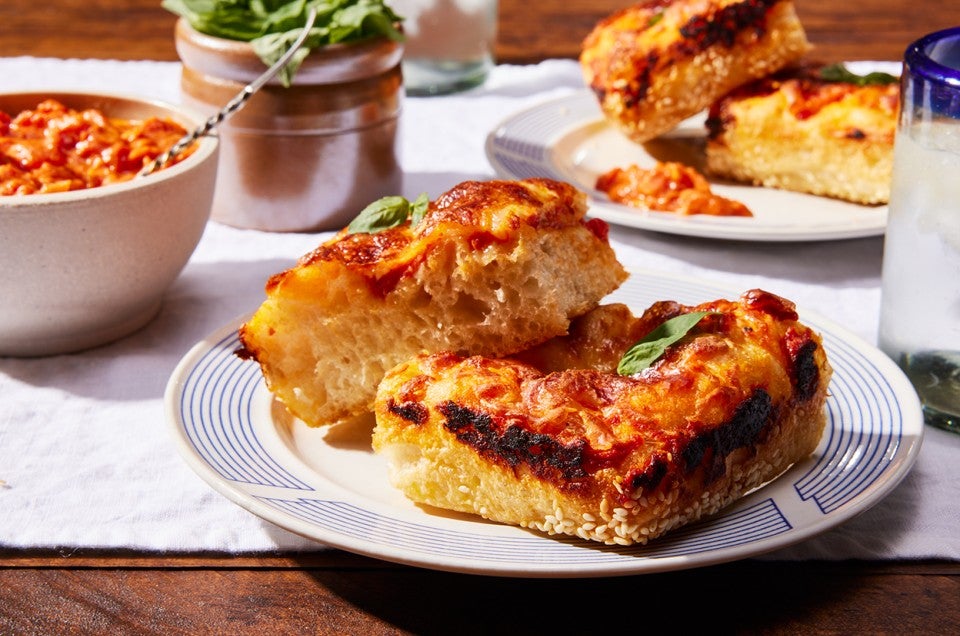-
To make the dough: Weigh your flour; or measure it by gently spooning it into a cup, then sweeping off any excess.
-
In a large bowl, whisk together the flour, salt, and yeast until well combined. Add the water and 1 generous tablespoon (15g) of the olive oil. Mix until thoroughly combined and homogenous.
-
Cover the dough and place it in a warm spot (about 70°F to 75°F) for 15 minutes, then give it a bowl fold: Use a wet hand to grab a section of dough from one side, lift it up, then press it down into the middle. Give the bowl a quarter-turn (90°) and repeat 3 to 6 times, until you’ve circled the dough and it has become resistant to stretching.
-
Cover the dough, set aside for another 15 minutes, then perform the bowl fold again.
-
After the second bowl fold, cover the dough and allow it to rest for about 1 to 1 1/2 hours, until it’s slightly puffy but not necessarily doubled in size.
-
To shape the dough: Coat the inside of the 9" x 13" pan with the remaining 1 tablespoon of olive oil, being sure to oil up the sides of the pan. Transfer the dough into the pan and turn once to coat in oil.
-
Gently press and stretch the dough, using your fingertips to dimple the surface and encourage it to cover the entire pan. (If your dough resists, cover it, let it rest for 15 minutes, and try again.)
-
To add the sesame seed crust: Lift up two corners of the dough to expose half the pan. Evenly sprinkle half the sesame seeds onto the oiled pan. (It’s OK if the dough rests on itself while you sprinkle the sesame seeds. It shouldn’t stick.) Place dough back onto pan. Repeat on the opposite side, so the bottom of the pan is evenly sprinkled with sesame seeds. (It’s fine if some sesame seeds get on the top of the dough.) Gently press the dough all over with your fingertips so that the sesame seeds adhere.
-
Cover the dough and let it rest for an additional 45 to 60 minutes, until slightly puffed; there should be some bubbles on the surface and edges, but the dough will not have doubled.
-
In the last 45 minutes of the rise time, preheat the oven to 500°F with a baking stone or steel on the bottom rack. While the oven is preheating, make the sauce.
-
To make the sauce: In a large saucepan, heat the olive oil over medium heat. Add the onions and garlic and sauté until softened, about 3 minutes. Add the red pepper flakes and stir until fragrant, about 30 seconds. Add the vodka and scrape the bottom of the pan to release any stuck-on brown bits. Add the tomatoes and bring to a boil. Reduce the heat to a simmer, and allow the sauce to reduce until significantly thickened, about 25 to 30 minutes.
-
Add the heavy cream and stir to combine. Season the sauce with salt and pepper to taste. Simmer for an additional 5 to 10 minutes, until the sauce is somewhat thickened.
-
To assemble the pizza: Top the pizza with 1 cup (about 270g) of sauce, spreading it to the edges. (A small offset spatula is a helpful tool here.) Then evenly sprinkle the cheese on top the sauce. For a more traditional pizza, leave a 1/2" border around the edge of the crust bare. (See “tips,” below, for instructions on how to make a pizza with a crispy cheesy “frico” edge.)
-
To bake the pizza: Just before baking, lower the oven temperature to 450°F. Bake the pizza for 20 to 25 minutes, or until the cheese is bubbling and the bottom and edges of the crust are golden brown (use a spatula to check the bottom). If the bottom is brown but the top still seems pale, transfer the pizza to the top rack and bake for 2 to 4 minutes longer. On the other hand, if the top seems fine but the bottom is not browned to your liking, leave the pizza on the stone/steel for another 2 to 4 minutes. Home ovens can vary widely, so use visual cues and your own preferences to gauge when you’ve achieved the perfect bake.
-
Remove the pizza from the oven and place the pan on a heatproof surface. Let the pizza cool very briefly, then carefully slide it from the pan to a cooling rack or cutting surface. (This will prevent the crust from becoming soggy.) Top pizza with basil and additional red pepper flakes (to make your spicy pizza even spicier!).
-
Storage instructions: The spicy pizza is best enjoyed the day it’s baked. Store leftovers in an airtight container at room temperature for up to 2 days; reheat, wrap in foil and place in a low-temperature oven until warm.






















